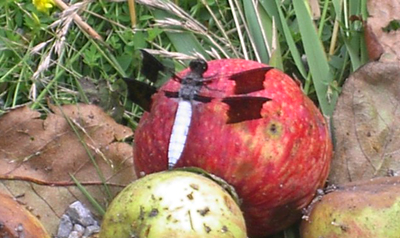Though I’m interested in all aspects of natural history, my focus these days is (obviously) on birds. Still, I’ve always been very interested in invertebrates, particularly dragonflies. My usual practice is to take a picture of any fascinating specimen that sits still long enough to allow it in the hope that one day I’ll be able to put a name to the multi-faceted face. My follow-up practice, however, is to spend to much time on other matters to pursue invertebrate identification. Consequently, these beautiful bugs tend to go unnamed.
However, if you read enough nature blogs, as I most certainly do, every vital piece of knowledge eventually comes your way. For many years, I’ve admired the following dragonfly, photographed for posterity during our first trip to Great Swamp NWR:

This chunky critter, looking for all the world like a jet-powered maggot, was so arresting that I had to snap its picture, despite its perch atop a pile of rotting apples. Who knows… maybe that was part of the attraction. Anyway, I’ve gone more than three years ignorant of this ode’s appellation. Now, thanks to Kingfisher, I’ve learned that it is a Common Whitetail.
The Common Whitetail (Libellula lydia) is both common, at least in North America, and white-tailed, at least as far as the males are concerned. The females of this species, also known as the Long-tailed Skimmer, have brown bodies. These fat-bodied dragonflies display very territorial behavior during their short adult lives. They eat mosquitoes and other flying insects, but also exhibit an occasional fondness for rotting apples.











You might want to check out Urban Dragon Hunters (http://www.urbanodes.blogspot.com) for info on the surprising number of dragonflies that can be found in an urban area.
I have found this site useful for learning the common species. It’s a personal site of photos taken in Maryland.
Great suggestions, guys. Thanks.
There’s always the *Dragonflies through Binoculars* book.
I have the Stokes Beginner’s Guide to Dragonflies which is a great little book for someone just starting to learn these beauties.
Thanks! Great pic & Info. I’ve often seen those and wondered what they were called.
Mike,
Don’t get “Dragonflies through Binoculars”. It’s crap. (Sorry Laura). The pics are too small and not to scale. If you want a field guide, get the Stokes book. It’s amazing. When you get enough out of that, get the “Dragonflies and Damselflies of Massachusetts.” Most, if not all, of the species you will encounter are in there. Let’s plan to go out “Ode-ing” as they call it this summer. I have a net for catch & release too. Also, check out http://www.njodes.com.
Can you tell I like dragonflies?
Patrick,
I kind of feel that way about the whole series – much too intimidating and frustrating to sort through, especially in the field!
I thought it might be sacrilege to say so though!
I love the little Stokes Guides and have bought many for friends who are just starting to learn birds or butterflies or dragonflies.
I’ll have to look for the other one you mentioned at SHBO.
I have been informed that the dragonfly site I referenced above has moved to http://southernspreadwing.com/.
Wow, I’m detecting a lot of passion for dragonflies out there. Maybe I’ll start a new blog. How many dragonfly species are there…
Anyway, Patrick, I’m all for Ode-ing when the season gets here. Right now, I’m looking forward to some winter owling.